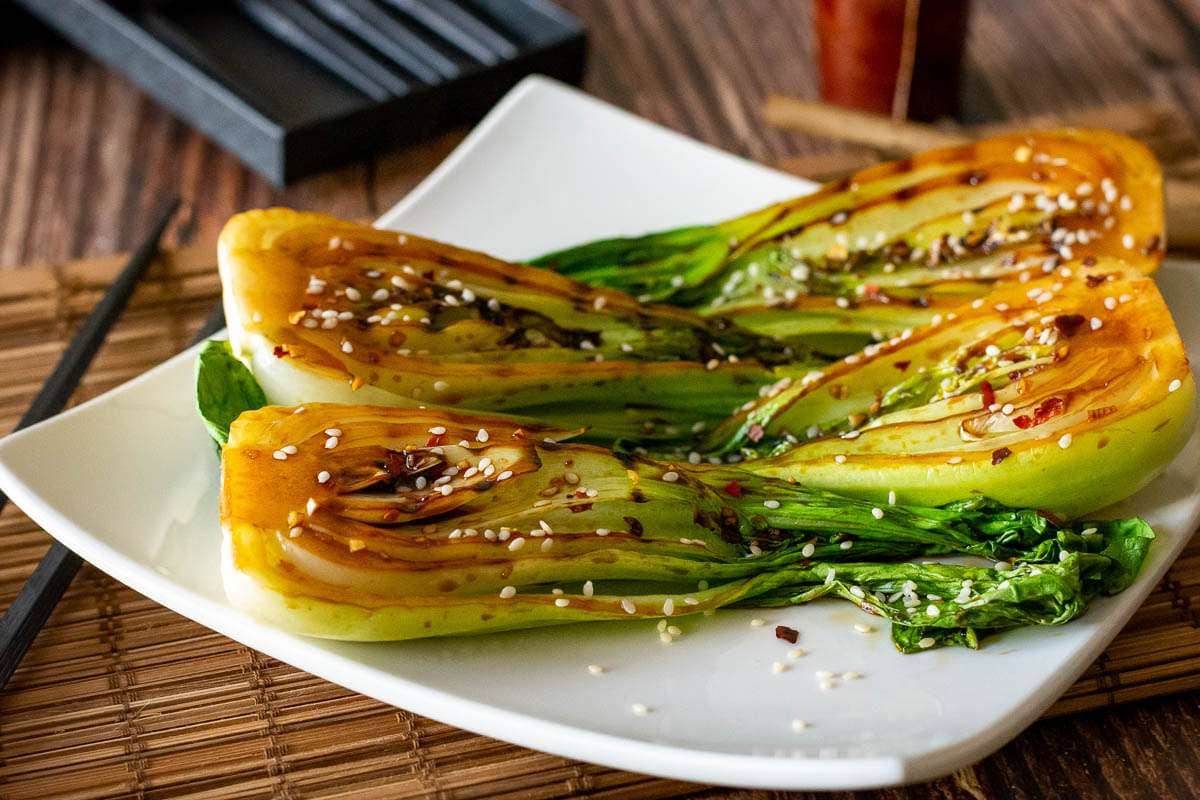Introduction
Pak choi, also known as bok choy or Chinese cabbage, is a leafy green vegetable that is popular in many Asian cuisines. It has a mild and slightly sweet flavor, with tender leaves and crisp stalks, making it a versatile ingredient in various dishes. If you’re new to cooking with pak choi, you might be wondering how to make the most out of this delicious vegetable. In this blog post, we’ll provide you with a comprehensive guide on how to cook pak choi, including preparation, cooking techniques, and some tasty recipe ideas.
Preparing Pak Choi
Before you start cooking pak choi, it’s essential to prepare it properly. Here are the steps to follow:
- Choose fresh pak choi: Look for pak choi with vibrant green leaves and firm stalks. Avoid any with wilted leaves or brown spots.
- Rinse thoroughly: Rinse the pak choi under cold water to remove any dirt or debris. Gently shake off the excess water and pat dry with a clean towel.
- Trim the ends: Trim the ends of the pak choi stalks, removing any discolored or tough parts.
- Separate the leaves: If the pak choi has large leaves, you may want to separate them from the stalks for easier cooking. Simply grip the stalks and pull the leaves away gently.
- Cut into desired size: Cut the pak choi stalks and leaves into the desired size for your recipe. You can chop them into small pieces, slice them lengthwise, or leave them whole, depending on your preference.
Cooking Techniques for Pak Choi
There are several cooking techniques that work well with pak choi, depending on the dish you want to make. Here are some popular methods:
Stir-frying:
Stir-frying is a common cooking technique used in Asian cuisine that works wonderfully with pak choi. Heat a wok or a large skillet over high heat, add some oil (such as vegetable or sesame oil), and swirl it around to coat the pan. Add the pak choi stalks first and cook for a minute or two until they start to soften. Then add the leaves and cook for another minute or two until wilted. Season with salt, pepper, and any other desired seasonings or sauces, and stir-fry for another minute or two. Serve hot as a side dish or add it to a stir-fry with other vegetables, meats, or noodles for a complete meal.
Boiling:
Boiling is a simple and quick way to cook pak choi while preserving its vibrant green color and crisp texture. Bring a pot of water to a boil, add salt if desired, and blanch the pak choi for 1-2 minutes until the leaves are wilted but still bright green. Drain the pak choi and transfer it to a bowl of ice water to stop the cooking process and maintain its color. Once cooled, drain again and pat dry with a towel. You can season the boiled pak choi with a drizzle of sesame oil, soy sauce, or oyster sauce, and serve it as a side dish or add it to soups, stews, or noodle dishes.
Steaming:
Steaming is another healthy way to cook pak choi, as it retains most of its nutrients and natural flavors. Place a steamer basket over a pot of boiling water, making sure the water doesn’t touch the bottom of the basket. Arrange the pak choi stalks and leaves in the steamer basket and cover with a lid. Steam for 3-5 minutes until the leaves are wilted and the stalks are tender but still slightly crisp. Season with salt, pepper and any desired sauces, and serve hot as a side dish or add it to rice, noodles, or other dishes.
Grilling:
Grilling pak choi can add a smoky and slightly charred flavor to this leafy green vegetable. Cut the pak choi in half lengthwise, leaving the stalks intact. Brush the cut side with oil (such as olive oil) and season with salt, pepper, and any desired herbs or spices. Preheat a grill or a grill pan over medium-high heat and place the pak choi cut-side down. Grill for 2-3 minutes until grill marks appear and the pak choi is slightly wilted but still crisp. Flip and grill for another 1-2 minutes. Remove from the grill, drizzle with some lemon juice or sesame oil, and serve as a unique and delicious side dish.
Roasting:
Roasting pak choi in the oven can result in a caramelized and tender dish with a depth of flavor. Preheat your oven to 400°F (200°C). Cut the pak choi in half lengthwise, leaving the stalks intact. Place them on a baking sheet lined with parchment paper. Brush with oil and season with salt, pepper, and any desired herbs or spices. Roast in the oven for 10-12 minutes until the leaves are wilted and the stalks are tender, flipping halfway through. Remove from the oven, drizzle with some balsamic glaze or soy sauce, and serve hot as a delicious and nutritious side dish.
Tasty Recipe Ideas
Now that you know how to cook pak choi using different techniques, here are some tasty recipe ideas to inspire you:
Garlic Ginger Pak Choi Stir-Fry:
Heat a wok or a skillet over high heat, add some oil, and swirl it around to coat the pan. Add minced garlic and ginger and stir-fry for a minute until fragrant. Add pak choi stalks and cook for 1-2 minutes until slightly softened. Then add the leaves and stir-fry for another minute until wilted. Season with soy sauce, oyster sauce, and a pinch of sugar, and stir-fry for another minute. Serve hot with steamed rice or noodles for a flavorful and nutritious meal.
Sesame Grilled Pak Choi:
Cut pak choi in half lengthwise, brush with sesame oil, and season with salt, pepper, and sesame seeds. Grill on a hot grill for 2-3 minutes per side until slightly charred and wilted. Remove from the grill, drizzle with more sesame oil and soy sauce, and sprinkle with green onions and cilantro. Serve as a unique and tasty side dish or appetizer.
Creamy Pak Choi Soup:
In a pot, sauté minced garlic and onions in some butter until fragrant. Add chopped pak choi stalks and cook for 2-3 minutes until slightly softened. Then add vegetable or chicken broth and bring to a boil. Reduce heat and simmer for 10-12 minutes until the stalks are tender. Use an immersion blender or a regular blender to puree the soup until smooth. Stir in some heavy cream, lemon juice, and salt to taste. Heat the soup again over low heat and add pak choi leaves. Cook for 1-2 minutes until wilted. Ladle the soup into bowls and garnish with chopped fresh parsley or chives. Enjoy a creamy and comforting bowl of pak choi soup.
Shrimp and Pak Choi Stir-Fry:
Heat a wok or a skillet over high heat, add some oil, and swirl it around to coat the pan. Add peeled and deveined shrimp and stir-fry for 2-3 minutes until they turn pink and opaque. Remove the shrimp from the pan and set aside. In the same pan, add more oil if needed and then add minced garlic and ginger. Stir-fry for a minute until fragrant. Add pak choi stalks and cook for 1-2 minutes until slightly softened. Then add the leaves and stir-fry for another minute until wilted. Return the cooked shrimp to the pan and season with soy sauce, fish sauce, and a pinch of sugar. Stir-fry for another minute. Serve hot with steamed rice or noodles for a delicious and protein-packed meal.
Pak Choi and Mushroom Stir-Fry:
Heat a wok or a skillet over high heat, add some oil, and swirl it around to coat the pan. Add sliced mushrooms and stir-fry for 2-3 minutes until they release their moisture and start to brown. Add minced garlic and ginger, and stir-fry for another minute until fragrant. Add pak choi stalks and cook for 1-2 minutes until slightly softened. Then add the leaves and stir-fry for another minute until wilted. Season with soy sauce, oyster sauce, and a pinch of sugar, and stir-fry for another minute. Serve hot with steamed rice or noodles for a flavorful and nutritious vegetarian meal.
Health Benefits of Pak Choi
Pak choi is not only delicious, but it also comes with a host of health benefits. Here are some reasons why you should consider incorporating pak choi into your diet:
- Nutrient-rich: Pak choi is packed with essential vitamins and minerals, including vitamins A, C, K, and B6, as well as calcium, iron, and potassium. These nutrients are important for maintaining healthy bones, promoting immune function, and supporting overall well-being.
- Antioxidant properties: Pak choi contains antioxidants, such as beta-carotene and vitamin C, which help neutralize harmful free radicals in the body and reduce the risk of chronic diseases, such as heart disease and cancer.
- High fiber content: Pak choi is an excellent source of dietary fiber, which promotes digestive health, regulates blood sugar levels, and helps maintain a healthy weight.
- Low in calories: Pak choi is a low-calorie vegetable, making it a great option for those watching their caloric intake. It can be a filling and satisfying addition to your meals without adding excess calories.
- Anti-inflammatory properties: Pak choi contains anti-inflammatory compounds, such as glucosinolates, which have been shown to help reduce inflammation in the body and promote overall health.
Incorporating pak choi into your diet can be a flavorful and nutritious way to boost your health and well-being. With its versatility in cooking techniques and delicious taste, pak choi can be a fantastic addition to your culinary repertoire.
Last Thoughts
Pak choi is a versatile and nutrient-rich leafy green vegetable that can be easily incorporated into your diet. From stir-fries and soups to grilling and roasting, there are many ways to cook pak choi and enjoy its unique flavor and health benefits. Whether you’re a seasoned cook or a beginner in the kitchen, give pak choi a try and elevate your culinary creations to new heights. So, next time you’re at the grocery store or farmers’ market, pick up some fresh pak choi and get ready to whip up some delicious and nutritious meals!





